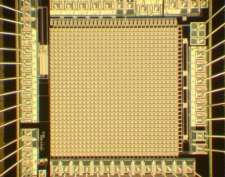3D CMOS camera for your mobile?

(PhysOrg.com) -- European researchers have created a world-leading camera in CMOS that can record photons at a million times a second. Best of all, it will be really cheap to manufacture, offering applications in consumer products, entertainment and in-car safety systems.
The Megaframe project created a high-speed camera that can detect 1024 photons at one million frames a second. While their work has put Europe in the lead of this particular field of research, the real news is that the team still cannot keep up with the number of potential applications for their technology.
At every conference or workshop they attend new potential applications emerge, and while the most significant impact of their work will probably be in the domain of biomedical science, their consumer and industrial applications will probably have widespread impact.
Take, for example, the automotive industry. Imagine a camera capable of working in a car engine cylinder and tracking the cylinder cycles in real time. It could provide enormous opportunity for in-car safety systems, diagnostics and fuel efficiency.
Using the information provided by the in-cylinder camera, engineers could develop cars that tune the engine on the fly, guaranteeing the best performance for real driving conditions.
Cheap as chips
And the main reason Megaframe’s camera could be applied to this particular field is that it is incredibly cheap. “CMOS, or complementary metal-oxide-semiconductor, is very cheap to produce, once the design has been mastered,” explains Edoardo Charbon, coordinator of the Megaframe project.
It means the technology could be applied in any number of devices and areas where it would serve a useful purpose. The utility of the camera has just begun to be explored.
That is because the camera does three things very well. It can detect very low light levels, ultimately a single photon, it can detect a photon a million times a second and, crucially, it can detect when the photon hits the detector to an incredible degree of accuracy. The Megaframe chip has a time resolution that ranges from 50-200 picoseconds.
The team achieved that by combining SPADs, or Single-Photon Avalanche Diodes, high-precision chronometers and microlenses into each pixel, and then created a 32 by 32 array of these pixels. It was an incredible demonstration of miniaturisation.
This accuracy is an enormous boost to ‘time-of-light’ 3D video. Time of light judges the depth of field, or the distance of a particular object in a scene, by the time it takes light fired at the object to be reflected back. It is incredibly accurate when well done, but it requires enormous precision.
We have the precision
The Megaframe camera has that precision. “If you want to have a depth resolution of a few millimetres, you have to have a time resolution of a few picoseconds. That is another case in which time resolution is very important,” explains Charbon formerly with EPFL and now at TU Delft.
Megaframe has that resolution and Charbon believes that 3D cameras based on SPAD technology could be appearing in mobile phones in the next five years. A similar technology could appear in cars, too, and be used for 3D parking cameras.
Again, the cameras could be adopted for jet engines, or for any type of chemical or reactive process, to give a more detailed picture of processes as they happen, on the fly. It could provide a major boost to any number of industrial processes, or to quality control. This is a major shift for a technology that once languished as a novel, but not very interesting, phenomenon.
“When we started this project in 2004 our colleagues thought SPADs were something of a curiosity,” admits Charbon. “But now that they see it works, they are very interested and the technology has really been put on the map,” Charbon says.
Second phase
For now, the team is concentrating on the second phase of the EU-funded project, where they hope to expand their pixel array from a 32 by 32 array to a much larger one. It will dramatically increase the area that can be filmed at any one time.
Charbon would also like to see another phase to cover a series of possible applications and develop prototypes for those applications.
He predicts the project’s work will find its way into real-world applications soon. “The 3D camera could be on your mobile phone in five years, and biomedical applications in 10 years, or perhaps even less,” he emphasises.
In the meantime, Megaframe is always interested in meeting potential research partners, and is particularly keen to meet investors who are interested in developing the 3D camera technology.
Megaframe had a budget of just €2.46 million, with €1.85 million provided by the European Union. Given all the innovation, the vast potential applications and its world leadership in the field, the project has proven to be great value for money.
This is the third of a three-part special feature on the Megaframe project.
Part 1. Video camera that records at the speed of thought
Part 2. Filming photons, one million times a second
More information: www.megaframe.eu/
Provided by ICT Results


















